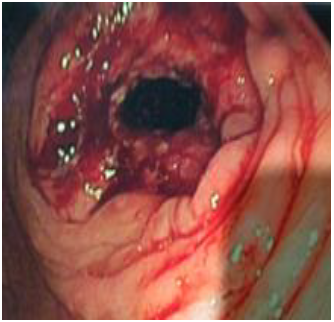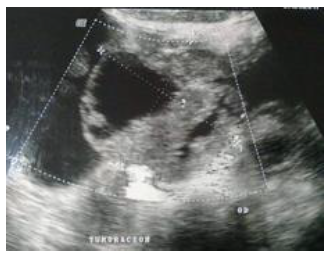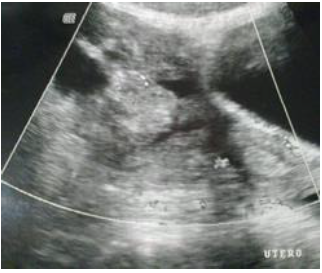Krukenberg Tumor in A 22 Year Old Patient with Primary Tumor in the Transverse Colon. Clinical Case
Article Information
Guillermo Padrón Arredondo*
General Surgery of Playa del Carmen General Hospital, Av. Constituyentes s/n c/Av. 135 Suburb Ejido, Playa del Carmen, Quintana Roo. Mexico
*Corresponding Author: Guillermo Padrón Arredondo, General Surgery of Playa del Carmen General Hospital, Av. Constituyentes s/n c/Av. 135 Suburb Ejido, Playa del Carmen, Quintana Roo. Mexico, Tel: +52 1 984 2061691;
Received: 12 July 2017; Accepted: 17 July 2017; Published: 21 July 2017
View / Download Pdf Share at FacebookAbstract
Background: In 1896 Friedrik Krukenberg described a bilateral ovarian tumor, which he called "mucocellular ovarii fibrosarcoma" (carcinomatodes), considering it to be fibrosarcomatous in nature. Clinical Case: A 22-year-old female patient admitted to the emergency department of our hospital with grade IV anemic syndrome. Two weeks after his admission to the emergency room, he presented melenic evacuations accompanied by asthenia, adynamia, hyporexia and dyspnea. His vital signs were normal except for TA 100/60 mmHg. Their laboratories of admission showed a hemoglobin of 6.3 g rest within normal parameters; Guayaco (++). First Ultrasound reported thickening of the colon walls. His control blood biometry reported hemoglobin of 3.4 g being transfused with globular packages increasing to 12.8 g. Carcinoembryonic antigens reported CA 19.9, 315.27, 15.3 = 7.29. A panendoscopy and colonoscopy was performed, reporting ulcerated lesions in the transverse stenotic colon. It refers to a Regional Hospital of High Specialty to the service of oncology for its integral management. Discussion: Previously, any metastatic ovarian cancer was categorized as Krukenberg's tumor; however, Novak and Gray established new diagnostic criteria to eliminate this confusion. Therefore, a mucin-secreting carcinoma with ring-seal cells in an ovarian fibroblast stroma is a Krukenberg tumor. Most of these tumors are of gastric origin (76%). Colorectal cancers carry a poor 5-year survival prognosis of only 13.1%.
Keywords
Krukenberg's tumor; Tumor of transverse colon; Metastatic ovary tumor
Krukenberg's tumor articles Krukenberg's tumor Research articles Krukenberg's tumor review articles Krukenberg's tumor PubMed articles Krukenberg's tumor PubMed Central articles Krukenberg's tumor 2023 articles Krukenberg's tumor 2024 articles Krukenberg's tumor Scopus articles Krukenberg's tumor impact factor journals Krukenberg's tumor Scopus journals Krukenberg's tumor PubMed journals Krukenberg's tumor medical journals Krukenberg's tumor free journals Krukenberg's tumor best journals Krukenberg's tumor top journals Krukenberg's tumor free medical journals Krukenberg's tumor famous journals Krukenberg's tumor Google Scholar indexed journals Tumor of transverse colon articles Tumor of transverse colon Research articles Tumor of transverse colon review articles Tumor of transverse colon PubMed articles Tumor of transverse colon PubMed Central articles Tumor of transverse colon 2023 articles Tumor of transverse colon 2024 articles Tumor of transverse colon Scopus articles Tumor of transverse colon impact factor journals Tumor of transverse colon Scopus journals Tumor of transverse colon PubMed journals Tumor of transverse colon medical journals Tumor of transverse colon free journals Tumor of transverse colon best journals Tumor of transverse colon top journals Tumor of transverse colon free medical journals Tumor of transverse colon famous journals Tumor of transverse colon Google Scholar indexed journals Metastatic ovary tumor articles Metastatic ovary tumor Research articles Metastatic ovary tumor review articles Metastatic ovary tumor PubMed articles Metastatic ovary tumor PubMed Central articles Metastatic ovary tumor 2023 articles Metastatic ovary tumor 2024 articles Metastatic ovary tumor Scopus articles Metastatic ovary tumor impact factor journals Metastatic ovary tumor Scopus journals Metastatic ovary tumor PubMed journals Metastatic ovary tumor medical journals Metastatic ovary tumor free journals Metastatic ovary tumor best journals Metastatic ovary tumor top journals Metastatic ovary tumor free medical journals Metastatic ovary tumor famous journals Metastatic ovary tumor Google Scholar indexed journals Transverse Colon articles Transverse Colon Research articles Transverse Colon review articles Transverse Colon PubMed articles Transverse Colon PubMed Central articles Transverse Colon 2023 articles Transverse Colon 2024 articles Transverse Colon Scopus articles Transverse Colon impact factor journals Transverse Colon Scopus journals Transverse Colon PubMed journals Transverse Colon medical journals Transverse Colon free journals Transverse Colon best journals Transverse Colon top journals Transverse Colon free medical journals Transverse Colon famous journals Transverse Colon Google Scholar indexed journals Primary Tumor articles Primary Tumor Research articles Primary Tumor review articles Primary Tumor PubMed articles Primary Tumor PubMed Central articles Primary Tumor 2023 articles Primary Tumor 2024 articles Primary Tumor Scopus articles Primary Tumor impact factor journals Primary Tumor Scopus journals Primary Tumor PubMed journals Primary Tumor medical journals Primary Tumor free journals Primary Tumor best journals Primary Tumor top journals Primary Tumor free medical journals Primary Tumor famous journals Primary Tumor Google Scholar indexed journals colonoscopy articles colonoscopy Research articles colonoscopy review articles colonoscopy PubMed articles colonoscopy PubMed Central articles colonoscopy 2023 articles colonoscopy 2024 articles colonoscopy Scopus articles colonoscopy impact factor journals colonoscopy Scopus journals colonoscopy PubMed journals colonoscopy medical journals colonoscopy free journals colonoscopy best journals colonoscopy top journals colonoscopy free medical journals colonoscopy famous journals colonoscopy Google Scholar indexed journals panendoscopy articles panendoscopy Research articles panendoscopy review articles panendoscopy PubMed articles panendoscopy PubMed Central articles panendoscopy 2023 articles panendoscopy 2024 articles panendoscopy Scopus articles panendoscopy impact factor journals panendoscopy Scopus journals panendoscopy PubMed journals panendoscopy medical journals panendoscopy free journals panendoscopy best journals panendoscopy top journals panendoscopy free medical journals panendoscopy famous journals panendoscopy Google Scholar indexed journals fibrosarcoma articles fibrosarcoma Research articles fibrosarcoma review articles fibrosarcoma PubMed articles fibrosarcoma PubMed Central articles fibrosarcoma 2023 articles fibrosarcoma 2024 articles fibrosarcoma Scopus articles fibrosarcoma impact factor journals fibrosarcoma Scopus journals fibrosarcoma PubMed journals fibrosarcoma medical journals fibrosarcoma free journals fibrosarcoma best journals fibrosarcoma top journals fibrosarcoma free medical journals fibrosarcoma famous journals fibrosarcoma Google Scholar indexed journals Colorectal cancers articles Colorectal cancers Research articles Colorectal cancers review articles Colorectal cancers PubMed articles Colorectal cancers PubMed Central articles Colorectal cancers 2023 articles Colorectal cancers 2024 articles Colorectal cancers Scopus articles Colorectal cancers impact factor journals Colorectal cancers Scopus journals Colorectal cancers PubMed journals Colorectal cancers medical journals Colorectal cancers free journals Colorectal cancers best journals Colorectal cancers top journals Colorectal cancers free medical journals Colorectal cancers famous journals Colorectal cancers Google Scholar indexed journals fibrosarcomatous articles fibrosarcomatous Research articles fibrosarcomatous review articles fibrosarcomatous PubMed articles fibrosarcomatous PubMed Central articles fibrosarcomatous 2023 articles fibrosarcomatous 2024 articles fibrosarcomatous Scopus articles fibrosarcomatous impact factor journals fibrosarcomatous Scopus journals fibrosarcomatous PubMed journals fibrosarcomatous medical journals fibrosarcomatous free journals fibrosarcomatous best journals fibrosarcomatous top journals fibrosarcomatous free medical journals fibrosarcomatous famous journals fibrosarcomatous Google Scholar indexed journals
Article Details
1. Background
In 1896 Friedrik Krukenberg described a bilateral ovarian tumor, which he called "mucocellular ovarii fibrosarcoma" (carcinomatodes), considering it to be fibrosarcomatous in nature. In 1916 Stone drew attention to metastatic cancer emphasizing the possible routes of dissemination to the ovary. In 1917, special attention was paid to Krukenberg's tumors by finding another bilateral ovarian tumor in a 33-year-old patient with lymphatic involvement but without finding the primary tumor in the digestive tract. In 1918 Mayor described blood dissemination by finding tumor cells in the pulmonary circulation during autopsy. Krukenberg in his original report considered the ovarian tumor as primary. Major, with reference to the cases collected until 1918, was able to affirm that of 55 cases he could attach 8 more cases. In 18 cases they found a primary tumor of the digestive system [1].
2. Clinical Case
A 22-year-old female, null, who enters the emergency department of our hospital with grade IV anemic syndrome. As background, he reported that 4 months ago he started with digestive disorders with intermittent diarrhea accompanied by pain in the right hypochondrium. Two weeks after his admission to the emergency room, he presented melenic evacuations accompanied by asthenia, adynamia, hyporexia and dyspnea. His vital signs were normal except for TA 100/60 mmHg. Their laboratories of admission showed a hemoglobin of 6.3 g rest within normal parameters, Guayaco (++). Ultrasound reported thickening of the colon walls. Her control Bh reported a hemoglobin of 3.4 being transfused with globular packets increasing to 12.8 g. Carcinoembryonic antigen reported CA 19.9, 315.27, 15.3 = 7.29. Panendoscopy was performed without significant findings. A colonoscopy was performed, reporting ulcerated lesions in the transverse stenotic colon. Figure 1. New ultrasound reported ovarian tumor (likely dysgerminoma) Figure 2 and 3. The CT scan reported complex cystic lesions in the pelvic cavity due to probable ovarian tube vs. abscesses. Epithelial neoplasia (cystadenocarcinoma or cystadenoma). The patient improves his hemodynamic status, ascites fluid sample is taken to search for tumor cells, resulting negative and refers to a Regional Hospital of High Specialty of the Peninsula of Yucatán for its integral management. Where she underwent surgery and is currently receiving adjuvant chemotherapy.

Figure 1: Ulcerated tumor in the transverse colon with proximal stenosis and stigmas of recent hemorrhage.

Figure 2: Ovarian tumor (likely dysgerminoma).

Figure 3: Right ovary tumor.
3. Discussion
Currently the term Krukenberg tumor (TK) indicates only metastatic ovarian cancer originating from another primary tumor, but the WHO has established criteria to establish this diagnosis based on the involvement of stromal tissue with proliferating mucin-producing neoplastic seal ring cells Ovarian stromal sarcomatoid. When an ovarian tumor is detected, the initial question should be whether the tumor is primary or is metastatic. TKs are rare and account for only 1% to 2% of all ovarian tumors and their incidence is approximately 0.16 per 100,000 per year. The majority of cases occur between 20 and 60 years of age and are more common in premenopausal women [2]. Previously, any metastatic ovarian cancer was categorized as TK; However, Novak and Gray [3] established new diagnostic criteria to eliminate this confusion. Therefore, a mucin-secreting carcinoma with ring-seal cells in a fibroblast ovarian stroma is referred to as TK [4].
Most of the TK are gastric origin (76%), however, the primary one may be of intestine (colon) 11%, biliary system 3%, cecal appendix 3%, pancreas, urinary bladder, cervix, breast and renal pelvis. They can also be primary. About 80% are bilateral in our case. The presence of the tumor through imaging has a very poor prognosis with a survival range of 12 to 23.4%. Our case was presented as a severe hemorrhagic event of the colon and later ovarian tumors and mild ascites were found [5].
The time between diagnosis of the primary tumor to the development of metastasis to ovary is variable and can range from months to 10 years in our patient due to its debut as a severe hemorrhagic event precipitated the definitive diagnosis. Pre- and postoperative fluctuating levels of CA 125 levels can be used as markers for follow-up of these patients following complete tumor resection. Immunohistochemistry is a valuable resource for the differentiation of metastatic primary ovary tumors, hence the profile of cytokeratin CK 7 (+) and CK 20 (-) are in favor of primary ovarian tumor and vice versa [6].
Similarly, TK can mimic a mucinous ovarian cystadenoma at the beginning of an assessment of patients and immunohistochemical studies are indispensable to differentiate these tumors [7]. Regarding the treatment of these tumors, resective surgery still plays an important role, however, chemotherapy and cytoreduction are important adjuvants in the integral treatment of these patients, in our case the ascites fluid sample was negative for Tumor cells, which gives us hope that the dissemination was not very large at that time [8].
Colorectal cancers carry a poor 5-year survival prognosis of only 13.1% and treatments guided by the tumor profile suggest a benefit in cases of advanced stage cancers [9]. When comparing survival in TKs of gastric origin versus those of colonic origin, the latter have a better survival than the former [10]. Rodríguez-Wong U et al. Also reported a case similar to ours with a primary tumor in the transverse colon, although in an older woman with good results [11].
Similarly, a tumor that included the gastric body and the transverse colon may be present, with a surgically operated gastric perforation and subsequently followed by a bilateral ovarian tumor, completing the surgical treatment plus polychemotherapy [12].
4. Conclusion
This type of tumor is very rare and is the first reported in our hospital, its prognosis is bad and given the presentation characteristics and age of the patient, we expect a favorable outcome.
References
- Reel PJ. Krukenberg tumor of the ovary. Ann Surg. 73 (1921): 481-486.
- Spinelli C, Liloia C, Piscioneri J, et al. An Unusual Evolution of Krukenberg Tumour: A Case Report. J Clin Diagn Res 10 (2016): PD07-PD11.
- Novak C, Gray LA. Krukenberg tumor of the ovary: Clinical and pathological study of four cases. Surg Gynecol Obstet 66 (1938): 157-165.
- Wu F, Zhao X, Mi B, et al. Clinical characteristics and prognostic analysis of Krukenberg tumor. Mol Clin Oncol 3 (2015): 1323-1328.
- Hiremath R, Padala KP, Mahesh, et al. Bilateral Krukenberg Tumours Diagnosed Primarily by Transabdominal Sonography- A Case Report. J Clin Diagn Res 9 (2015): TD01-TD032.
- Umakanthan S, Bukelo MM, Hardik K. A 36-year-old female with Krukenberg tumor from a colonic carcinoma. J Can Res Ther 11 (2015): 911-913.
- Shiono S, Saito T, Fujii H, et al. A case of Krukenberg carcinoma metastasized from colon cancer resembling mucinous cystadenocarcinoma of the ovary. Case Report. Int J Clin Exp Pathol 7 (2014): 394-401.
- Xu KY, Gao H, Lian ZJ, et al. Clinical Analysis of Krukenberg tumor in patients with colorectal cancer- A review of 57 cases. World J Surg Oncol 15 (2017): 25.
- El-Deiry WS, Vijayvergia N, Xiu J, et al. Molecular pro?ling of 6,892 colorectal cancer samples suggests different possible treatment options speci?c to metastatic sites. Cancer Biol Ther 16 (2015): 1726-1737.
- Jeung YJ, Ok HJ, Kim WG, et al. Krukenberg tumors of gastric origin versus colorectal origin. Obstet Gynecol Sci 58 (2015): 32-39.
- Rodríguez-Wong Ulises, Cruz-Reyes JM. Tumor de Krukenberg de origen colónico. Rev Hosp Jua Mex 74 (2007): 40-43.
- Mederos-Curbelo ON, Barrera-López A, Castellanos-González JA, et al. Adenocarcinoma mucoproductor de colon con infiltración de estómago y metástasis ováricas (tumor de Krukenberg). Rev Cub Cir 50 (2011): 576-583.


 Impact Factor: * 3.1
Impact Factor: * 3.1 CiteScore: 2.9
CiteScore: 2.9  Acceptance Rate: 11.01%
Acceptance Rate: 11.01%  Time to first decision: 10.4 days
Time to first decision: 10.4 days  Time from article received to acceptance: 2-3 weeks
Time from article received to acceptance: 2-3 weeks 
